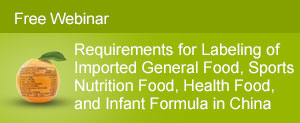FCM - Those products made of paper, bamboo, wood, metals, porcelain, ceramics, plastics, rubber, natural fibers, synthetic fibers, glass and composite packaging materials that are used for packing and holding food; and coatings in contact with food; and the equipments, pipes, conveyor belts, containers, tools and utensils that are in contact with food during the production and sales of food.
In China, food contact materials (FCMs) are regulated by China Food Safety Law issued in 2009. The Article 32 & 62 of China Food Safety Law prohibits the importation, use or purchase of food-related products (e.g., food additive, food packaging materials) not complying with applicable Chinese Food Safety Standards. There are currently over 130 National Standards & 125 Industry Standards for food package materials & containers in China and they set specific safety requirements (evaporation residue, migration of hazardous) on FCMs from three levels:
1. Specific material groups(paper & paper products, metal products, ceramics,);
2. Specific products;
3. Food contact additives;
In 2011, the Ministry of Health (MOH) has published the Measures on Administrative Permission of New Varieties of Food Related Products and the measures have set detailed requirements regarding notification of new varieties of food related products (including new food packaging materials and new food contact additives). According to the measures, the following documents are required for food contact notifications.
1. Application form and phys-chemical properties;
2. Technical necessity, uses and conditions of use;
3. Description of manufacturing process;
4. Quality and safety control, analytical methods and test reports;
5. Toxicology safety assessment data;
6. Migration limit test, estimation and assessment of dietary exposure;
7. Whether the additive has been approved or used in other countries;
8. Other information which is helpful to review;
It shall be noted that the required toxicology safety assessment data depends on the overall migration (OM). If the OM is very low, lots of toxicology data can then be exempted. According to MOH's draft guidance regarding approval of new food-related species, the following toxicology studies are required for food contact notification:
1. OM<0.01mg/kg: QSAR, read-across and literature data;
2. OM<0.01~0.05mg/kg: genetic toxicity test;
3. OM<0.05~5 mg/kg: genetic toxicity test, 90d oral study;
4. OM<5~60mg/kg: acute toxicity, genotoxicity, 90d oral, teratogenicity, reproductive toxicity, chronic toxicity and carcinogenicity.
Since the publication of the measures in 2011, 3 new food contact additives have been approved in the MOH’s notice 2012-11 in accordance with the measures.
About Us and Contact
Our services cover new substance notification, registration of the import and export of toxic chemicals, registration of hazardous chemicals, classification and labeling in according to China GHS, Chinese SDS, risk assessment of industrial chemicals, food additives and cosmetic ingredients. We provide one-stop solutions to your regulatory issues in China.We also deliver the most up-to-date regulatory information about chemical control laws in China.
-
Ms. Cathy Yu, Senior Consultant, Food Safety Regulation, CIRS China
11F Dongguan Building, 288 Qiuyi Road, Binjiang District, Hangzhou, China, 310020
Tel : +86 571 8720 6538 | Fax : +86 571 8720 6533
Email: cathy.yu@hfoushi.com






